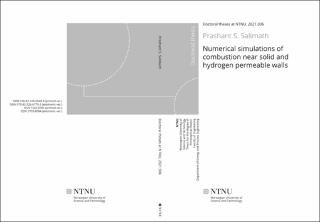| dc.contributor.advisor | Ertesvåg, Ivar Ståle | |
| dc.contributor.advisor | Gruber, Andrea | |
| dc.contributor.author | Salimath, Prashant S. | |
| dc.date.accessioned | 2021-09-10T07:44:34Z | |
| dc.date.available | 2021-09-10T07:44:34Z | |
| dc.date.issued | 2021 | |
| dc.identifier.isbn | 978-82-326-6770-3 | |
| dc.identifier.issn | 2703-8084 | |
| dc.identifier.uri | https://hdl.handle.net/11250/2775124 | |
| dc.description.abstract | The goal of the present thesis was to investigate a selective and isothermal, chemically inert hydrogen-permeable or porous wall boundary condition to laminar flame simulations to understand the flow physics of near-wall flames. It provides better physical insight into a flame quenching process near a hydrogen-permeable wall, its relation to wall heat fluxes and incomplete combustion leading to pollutant formation. The simulation results are crucial to obtain prediction capabilities for eventual future utilization as novel fuel diffuser in a conventional combustor fuel nozzle. The comparison of the impermeable wall results with permeable wall results gives a good indicator towards building fuel diffuser and identifying a margin of operating conditions for improving hardware lifetime.
First, transient processes of laminar flame-wall interaction and quenching near a porous, permeable wall were investigated for the temperature of 750 K. These results were compared against a reference case of a non-porous or solid wall. The results obtained for lean, stoichiometric and rich initial mixture conditions in premixed flame show that flame wall characteristics (wall heat flux and quenching distance) are affected by the flux of hydrogen gas through a porous wall. The presence of a feedback mechanism was observed between hydrogen flux at wall and flame, which influences boundary layer flashback speeds in 2-d side wall quenching (SWQ) cases. The strong feedback effect was observed at lean-fuel conditions.
Then, a laminar 1-d head-on quenching (HOQ) of hydrogen-air mixture for the permeable wall was extended to study the effects of varying wall mass flux, stoichiometry, inert dilution and unburned-gas and wall temperatures. In all cases, the maximum reaction heat release rate occurred at the wall. For rich and stoichiometric mixtures, a moderate reduction of the quenching (i.e.maximum) wall heat flux to permeable wall in comparison to reference impermeable wall, whereas for a lean mixture, the increase of quenching wall heat flux was considerable. The lean permeable wall cases have similarities to much richer impermeable wall cases. Both a lower wall temperature and dilution reduce the burned-mixture temperature and, consequently, the wall heat flux.
Furthermore, the flame wall interaction study with a hydrogen-permeable wall was extended to methane-air premixed flames. Permeable wall (PW) configurations were investigated for two temperatures at 600 and 750 K, of the wall and unburnt gas, and varying initial equivalence ratios. The solid wall results agreed with previous FWI studies. The mutual effects of convection heat transfer, flame behaviour and local fuel-air ratio, with reduced temperature and heat release rates, explain the flame quench before reaching the wall for PW cases. These effects were not observed for FWI of premixed hydrogen-air mixtures. The quenching definition of maximum heat flux was inappropriate to these cases. The OH radicals concentration was taken as a criterion for quenching definition and flame position.
Finally, the interaction of premixed hydrogen-air flame was extended to study local entropy generation and entropy fluxes towards a solid and hydrogen-permeable wall. Major findings were that conduction entropy generation remains dominant close to quenching, and that fuel permeation through the wall tends to reduce entropy generation per unit of converted fuel, particularly for initially lean mixtures. | en_US |
| dc.language.iso | eng | en_US |
| dc.publisher | NTNU | en_US |
| dc.relation.ispartofseries | Doctoral theses at NTNU;2021:306 | |
| dc.relation.haspart | Paper 1: Gruber, Andrea; Salimath, Prashant Siddlinggayya; Chen, Jacqueline H.. Direct numerical simulation of laminar flame-wall interaction for a novel H2-selective membrane/injector configuration. International Journal of Hydrogen Energy 2014 ;Volum 39.(11) s. 5906-5918 http://dx.doi.org/10.1016/j.ijhydene.2014.01.148 | en_US |
| dc.relation.haspart | Paper 2: Salimath, Prashant Siddlinggayya; Ertesvåg, Ivar Ståle; Gruber, Andrea. Premixed hydrogen-air flames interacting with a hydrogen porous wall. International Journal of Hydrogen Energy 2018 ;Volum 43.(7) s. 3822-3836 https://doi.org/10.1016/j.ijhydene.2017.12.166 | en_US |
| dc.relation.haspart | Paper 3: Salimath, Prashant; Ertesvåg, Ivar Ståle; Gruber, Andrea. Computational analysis of premixed methane-air flame interacting with a solid wall or a hydrogen porous wall. Fuel 2020 ;Volum 272. https://doi.org/10.1016/j.fuel.2020.117658 This is an open access article under the CC BY license (http://creativecommons.org/ licenses/by/4.0/). | en_US |
| dc.relation.haspart | Paper 4: Salimath, Prashant; Ertesvåg, Ivar Ståle. Local entropy generation and entropy fluxes of a transient flame during head-on quenching towards solid and hydrogen-permeable porous walls. International Journal of Hydrogen Energy 2021 ;Volum 46.(52) s. 26616-26630
https://doi.org/10.1016/j.ijhydene.2021.05.142
This is an open access article under the CC BY license (http://creativecommons.org/ licenses/by/4.0/). | en_US |
| dc.title | Numerical simulations of combustion near solid and hydrogen permeable walls | en_US |
| dc.type | Doctoral thesis | en_US |
| dc.subject.nsi | VDP::Technology: 500::Environmental engineering: 610 | en_US |
